You are using an out of date browser. It may not display this or other websites correctly.
You should upgrade or use an alternative browser.
You should upgrade or use an alternative browser.
Should I buy a revolver?
- Thread starter Miles2014
- Start date
Shooting double-action is/was a challenge for me. I can shoot one (ragged) hole groups at moderate distances with most semis. Doing that double-action has proven to be a challenge.
Thumbing the hammer at 'combat distances' seems counter-productive.
My dad has had a GP100 and SP101 for years. Great guns. I wanted something different, so I went with a 6" 586 and 4" 29.
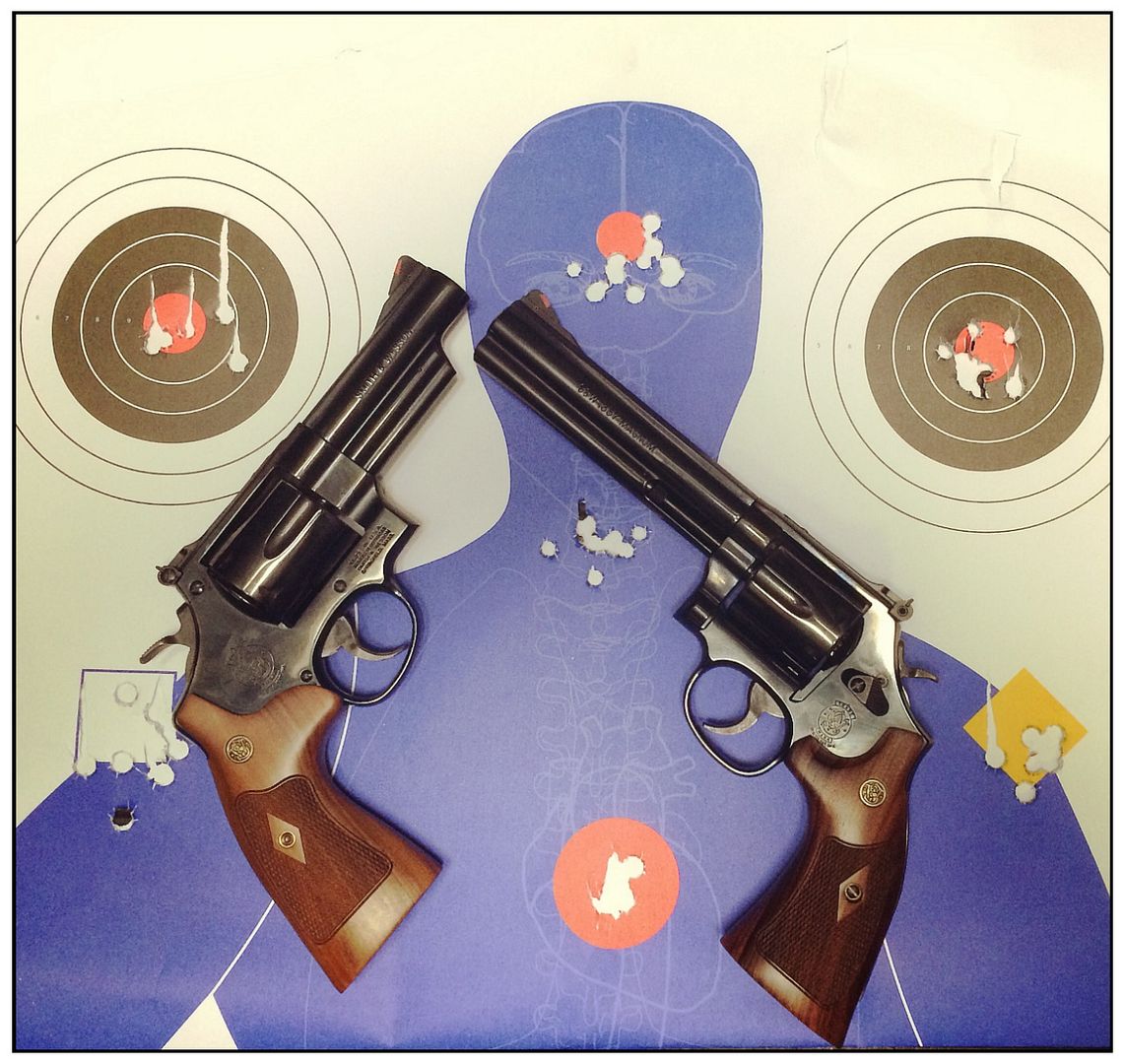
Thumbing the hammer at 'combat distances' seems counter-productive.
My dad has had a GP100 and SP101 for years. Great guns. I wanted something different, so I went with a 6" 586 and 4" 29.

2damnold4this
New member
I certainly enjoy my revolvers.
If you aren't sure you want a particular revolver, perhaps you can rent one at a range or borrow a friend's to see if you like it.
ps: Revolvers come in different flavors and while some can be difficult to shoot well, others are easy to shoot.
If you aren't sure you want a particular revolver, perhaps you can rent one at a range or borrow a friend's to see if you like it.
ps: Revolvers come in different flavors and while some can be difficult to shoot well, others are easy to shoot.
Driftwood Johnson
New member
I know they're a little challenging to shoot, but for those that own them, does it make sense to buy one?
Challenging? Really?
I have about ten times as many revolvers as semi-autos. I have been shooting revolvers for over 40 years.
Never considered them to be challenging.
Model12Win
Moderator
Miles...
You MUST acquire a classic revolver... it is... your destiny.

Seriously though they are fun. Looks for a used S&W without the internal lock hole. Something like a Model 67 would be great for you, not to expense, extremely nice to shoot. Here is mine that I just got done shooting today:

You MUST acquire a classic revolver... it is... your destiny.
Seriously though they are fun. Looks for a used S&W without the internal lock hole. Something like a Model 67 would be great for you, not to expense, extremely nice to shoot. Here is mine that I just got done shooting today:

Driftwood Johnson
New member
I know most people are adamant about preferring the pre lock versions, but are the new lock versions a big drop off? Has the quality dropped off that much, is there really a possibility that the lock could activate on a cycle?
Howdy Again
Actually, your question has two answers. The lock is a separate issue from the overall quality of the new Smiths.
Yes, quality has dropped off. That is the whole reason behind going to MIM parts. They can be made more cheaply than forged and machined parts. On top of that, they have been redesigned to be simpler to assemble, and most of the MIM parts in a modern S&W revolver need no hand fitting like the older parts did. So it is cheaper to make the parts and cheaper to put the gun together. Whether that means quality has been reduced depends on your point of view. I like the older hand fitted parts. An old Smith made with hand fitted parts was like a Swiss watch. A new one is more like an inexpensive watch you buy at a Big Box store. Do they both tell time? Absolutely. Does one do a better job of telling time? Probably not enough to matter in practical terms. Will you want to be handing the Big Box watch down to your Grand Kids? Probably not.
I have a couple of newer S&W revolvers with MIM parts, I bought them just to see what they are like. Frankly, to me the triggers on the MIM guns simply do not compare to the older guns. In addition, I can see one issue with my 686 that never would have made it out the door of the factory back when parts were being hand fitted. Does it shoot OK? Yes it does, but it shoots so far to one side that I had to crank the rear sight way over to one side to get it on target. That never would have happened when guns were hand fitted.
Will the lock fail? Probably not. In fact, I have no problem with the modern locks, it is the lack of quality that turns me off more than the lock.
But like the Big Box watch that tells time just fine, other than cranking the sight way over to the side, the 686 shoots fine.
But I can tell you that personally, I doubt if I will be buying any more modern Smiths with MIM parts.
Not when there are plenty of older Smiths out there that cost the same amount or less than a brand new one.
Of course, it does take a bit of experience to know what you are getting.
Kind of like buying a used car.
Driftwood Johnson
New member
Oh Boy, now I'm in trouble.
Smith and Wesson is a very old company. They produced their first revolvers in 1857. The revolvers produced in 1857, and throughout the Civil War bear very little resemblance to what came later. Like all profitable companies, S&W has always looked for ways to drive the cost out of manufacturing. That is only natural. And like many companies, sometimes completely new designs, unlike anything that came before, would be tried because the company thought they were a good idea and customers would like them. And sometimes technological advances would lead the company to try new methods that did not exist earlier.
The modern S&W revolvers with side swinging cylinders that we know today were pioneered at the beginning of the 20th Century. There were other designs before that, but I'm not going to go into them. But in 1896 they brought out their first side swing 32 caliber revolver, and in 1899 they brought out their first side swing 38 caliber revolver. In 1905 S&W perfected the 38 caliber side swing revolver, and all their revolvers made ever since then have had the same basic mechanism inside, right up to today. The parts may have been manufactured with different technologies, but they work the same as they did in 1905.
Right this number down. 1957. That is the year that S&W went to their current practice of numbering the different models they produced. Prior to 1957, the naming conventions could be confusing for the different models. The standard 38 Special revolver was usually called the 38 Military and Police. The standard 44 Special revolver was usually called a 44 Hand Ejector. There were specialized names too, Chief's Special, Regulation Police, were just a few of them. But in 1957 the company came up with a new numbering scheme. Models already in production had a model number assigned to them. The 38 M&P became the Model 10. The Chief's Special became the Model 36. The K-22 became the Model 17. The large frame 357 Magnum revolver became the Model 27, the 44 Magnum became the Model 29, it goes on and on. But you will know automatically what the gun is by opening the cylinder and looking at the frame under the yoke. The Model Number will be stamped there. It will say MOD-10 or something like that. As new models were developed, they were issued new model numbers.
Then as time went on and engineering changes were made to the various models, a dash number was added to the model name. So you may see MOD 10-3 or something similar. The higher the dash number, the newer the gun. Unfortunately you cannot make the assumption that all models went to the same dash number at the same time. Sorry, it did not work that way. Different models went to different dash numbers at different times.
The important thing to remember is if it has a model number, it was made in 1957 or later.
A couple of terms you might want to be familiar with. Pinned barrel. A pinned barrel means after the barrel was threaded into place, a hole was drilled through the frame and across the threads of the barrel. A pin was then driven into the hole, and the pin prevented the barrel from unscrewing. You can see the pin on this K-22. It is near the top of the frame in front of the cylinder. At some point S&W went to a more cost efficient way of preventing the barrel from unscrewing. They went to interference threads that would crush slightly as the barrel was screwed in. This cost less than the operations of drilling and pinning the barrel. It seems that pinned barrels were eliminated in 1982 on many models, but because different models were at different dash levels at that time, one cannot generalize at which dash number the pinned barrel was eliminated on all models.
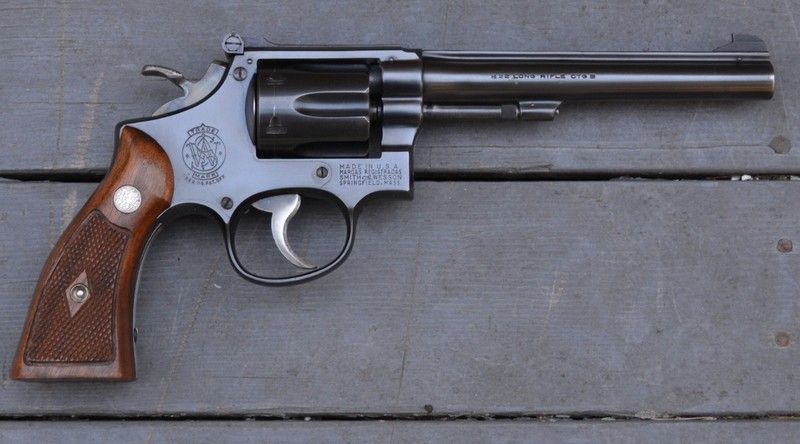
Another term that is useful with S&W revolvers is the number of screws. Five Screw, Four Screw, and Three Screw. Take another look at that K-22. It is a Five Screw revolver. You can see three screws holding the side plate onto the frame. There is one more screw hidden under the grip at the top corner of the grip. And there is one more screw, invisible in this view, in front of the trigger guard. That makes this revolver a Five Screw revolver. With only two exceptions that I am aware of, all the S&W Side Swing revolvers started out as Five Screw revolvers. Then around 1961 and 1962 the screw in front of the trigger guard was eliminated, making the Four Screw revolvers. Then, just a few years later the screw at the top corner near the hammer was eliminated. Since that time, all S&W revolvers have been Three Screw revolvers.
Let's look at the other side of that K-22. Look at the frame next to the lower right corner of the cylinder. There is a piece there that looks like a vertical semi-circle. That piece is called the cylinder stop stud. Without that part if you opened the cylinder and pointed the muzzle up, the cylinder would slide down and only be stopped from falling out of the gun by the front end of the extractor rod. The cylinder stop stud was a very simple part. It was a round stud, pressed into the frame from the inside and staked in place. After it was staked in place, it was machined to the shape you see to allow the cylinder to close without sliding backwards.
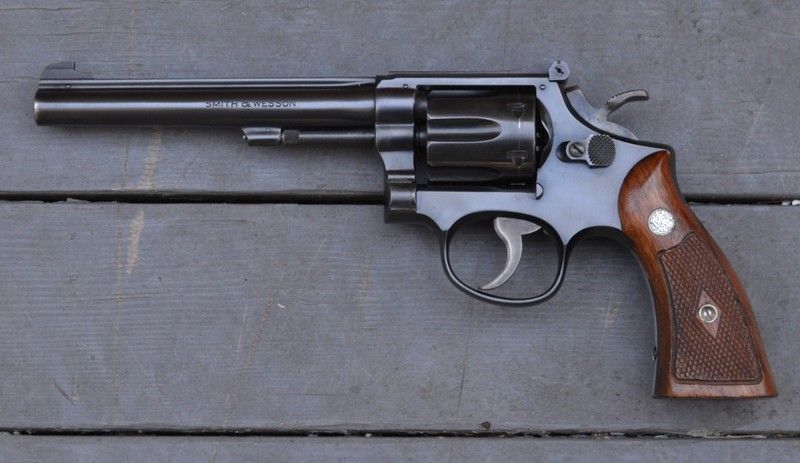
Now let's look at the side of the frame of a Model 617-6. This particular one was made in 2003. First of all, there is the key hole for the lock staring us in the face, right above the thumb piece. Some shooters have a vulgar name for the hole, but I will not repeat it here. But there it is, announcing the presence of the lock with no mistake. And notice that the cylinder stop stud has been replaced by a ledge or rib of metal machined directly onto the surface of the frame.
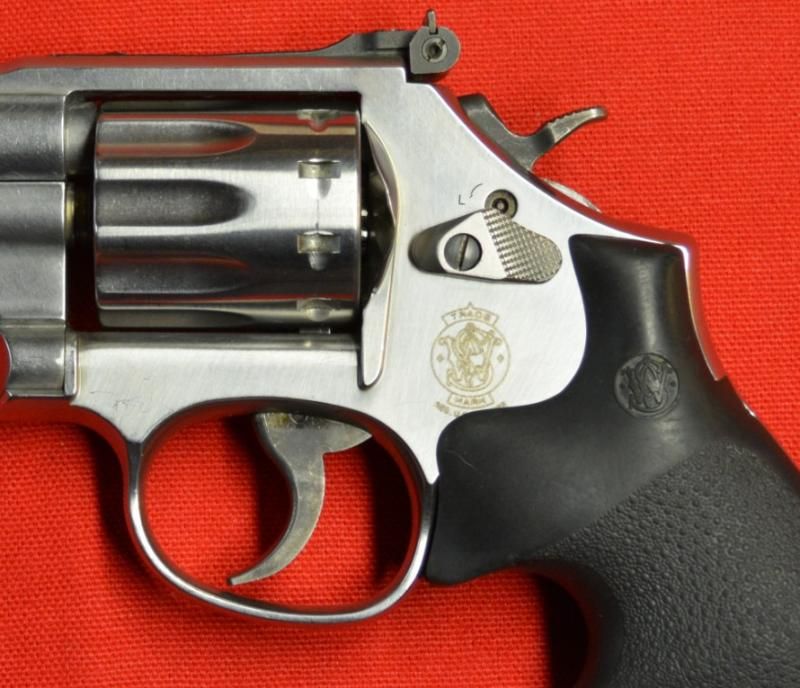
Here it is from a slightly different angle. The rib serves the same purpose as the cylinder stop stud, preventing the cylinder from sliding backwards, but it was much less expensive to add a few lines of code to the CNC program to cut the rib (or really to leave it standing) then it was to drill a hole, drive in the stud from the inside, stake it, and machine it to final shape as a secondary machining process. Now it so happens that S&W eliminated the cylinder stop stud at about the same time as they started going to MIM parts. This happened in 1997 with the Model 10-11. There are experts who can tell you exactly which happened first, installing the lock, or going to MIM parts, but for me, that rib of metal replacing the cylinder stop stud says it all. If it is there, I'm pretty sure there are MIM parts inside. If the old cylinder stop stud is there, there are probably forged and machined parts inside.
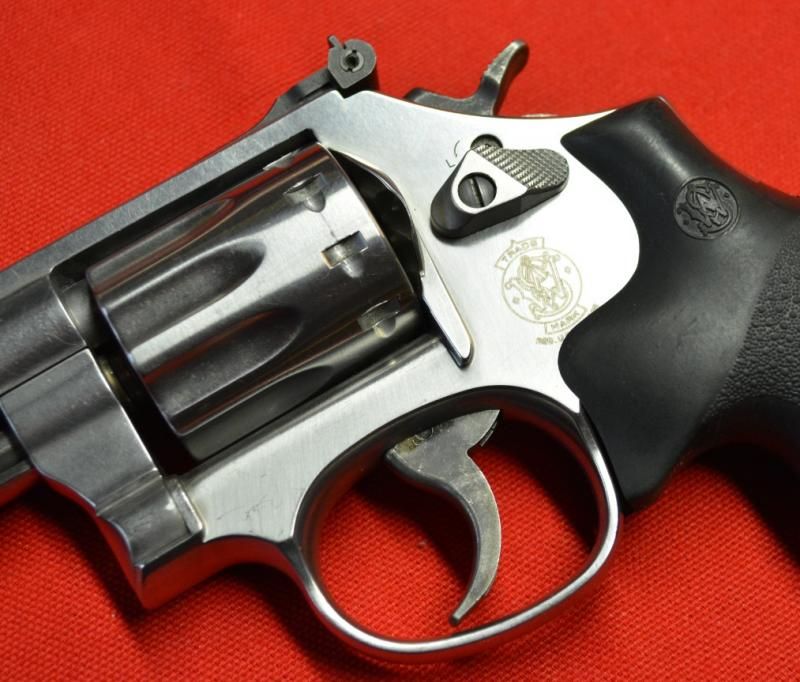
There are lots more details to learn about S&W construction, I have only shown you the tip of the iceberg. But that is how I can tell at a glance if there are MIM parts inside or not.
For a more in depth look at the difference between MIM parts and more traditional forged and machined parts you might want to check out this post I put on The High Road a couple of years ago:
https://www.thehighroad.org/index.php?threads/comparing-a-s-w-revolver-made-with-mim-parts-to-a-revolver-made-with-machined-parts.769929/
Smith and Wesson is a very old company. They produced their first revolvers in 1857. The revolvers produced in 1857, and throughout the Civil War bear very little resemblance to what came later. Like all profitable companies, S&W has always looked for ways to drive the cost out of manufacturing. That is only natural. And like many companies, sometimes completely new designs, unlike anything that came before, would be tried because the company thought they were a good idea and customers would like them. And sometimes technological advances would lead the company to try new methods that did not exist earlier.
The modern S&W revolvers with side swinging cylinders that we know today were pioneered at the beginning of the 20th Century. There were other designs before that, but I'm not going to go into them. But in 1896 they brought out their first side swing 32 caliber revolver, and in 1899 they brought out their first side swing 38 caliber revolver. In 1905 S&W perfected the 38 caliber side swing revolver, and all their revolvers made ever since then have had the same basic mechanism inside, right up to today. The parts may have been manufactured with different technologies, but they work the same as they did in 1905.
Right this number down. 1957. That is the year that S&W went to their current practice of numbering the different models they produced. Prior to 1957, the naming conventions could be confusing for the different models. The standard 38 Special revolver was usually called the 38 Military and Police. The standard 44 Special revolver was usually called a 44 Hand Ejector. There were specialized names too, Chief's Special, Regulation Police, were just a few of them. But in 1957 the company came up with a new numbering scheme. Models already in production had a model number assigned to them. The 38 M&P became the Model 10. The Chief's Special became the Model 36. The K-22 became the Model 17. The large frame 357 Magnum revolver became the Model 27, the 44 Magnum became the Model 29, it goes on and on. But you will know automatically what the gun is by opening the cylinder and looking at the frame under the yoke. The Model Number will be stamped there. It will say MOD-10 or something like that. As new models were developed, they were issued new model numbers.
Then as time went on and engineering changes were made to the various models, a dash number was added to the model name. So you may see MOD 10-3 or something similar. The higher the dash number, the newer the gun. Unfortunately you cannot make the assumption that all models went to the same dash number at the same time. Sorry, it did not work that way. Different models went to different dash numbers at different times.
The important thing to remember is if it has a model number, it was made in 1957 or later.
A couple of terms you might want to be familiar with. Pinned barrel. A pinned barrel means after the barrel was threaded into place, a hole was drilled through the frame and across the threads of the barrel. A pin was then driven into the hole, and the pin prevented the barrel from unscrewing. You can see the pin on this K-22. It is near the top of the frame in front of the cylinder. At some point S&W went to a more cost efficient way of preventing the barrel from unscrewing. They went to interference threads that would crush slightly as the barrel was screwed in. This cost less than the operations of drilling and pinning the barrel. It seems that pinned barrels were eliminated in 1982 on many models, but because different models were at different dash levels at that time, one cannot generalize at which dash number the pinned barrel was eliminated on all models.

Another term that is useful with S&W revolvers is the number of screws. Five Screw, Four Screw, and Three Screw. Take another look at that K-22. It is a Five Screw revolver. You can see three screws holding the side plate onto the frame. There is one more screw hidden under the grip at the top corner of the grip. And there is one more screw, invisible in this view, in front of the trigger guard. That makes this revolver a Five Screw revolver. With only two exceptions that I am aware of, all the S&W Side Swing revolvers started out as Five Screw revolvers. Then around 1961 and 1962 the screw in front of the trigger guard was eliminated, making the Four Screw revolvers. Then, just a few years later the screw at the top corner near the hammer was eliminated. Since that time, all S&W revolvers have been Three Screw revolvers.
Let's look at the other side of that K-22. Look at the frame next to the lower right corner of the cylinder. There is a piece there that looks like a vertical semi-circle. That piece is called the cylinder stop stud. Without that part if you opened the cylinder and pointed the muzzle up, the cylinder would slide down and only be stopped from falling out of the gun by the front end of the extractor rod. The cylinder stop stud was a very simple part. It was a round stud, pressed into the frame from the inside and staked in place. After it was staked in place, it was machined to the shape you see to allow the cylinder to close without sliding backwards.

Now let's look at the side of the frame of a Model 617-6. This particular one was made in 2003. First of all, there is the key hole for the lock staring us in the face, right above the thumb piece. Some shooters have a vulgar name for the hole, but I will not repeat it here. But there it is, announcing the presence of the lock with no mistake. And notice that the cylinder stop stud has been replaced by a ledge or rib of metal machined directly onto the surface of the frame.

Here it is from a slightly different angle. The rib serves the same purpose as the cylinder stop stud, preventing the cylinder from sliding backwards, but it was much less expensive to add a few lines of code to the CNC program to cut the rib (or really to leave it standing) then it was to drill a hole, drive in the stud from the inside, stake it, and machine it to final shape as a secondary machining process. Now it so happens that S&W eliminated the cylinder stop stud at about the same time as they started going to MIM parts. This happened in 1997 with the Model 10-11. There are experts who can tell you exactly which happened first, installing the lock, or going to MIM parts, but for me, that rib of metal replacing the cylinder stop stud says it all. If it is there, I'm pretty sure there are MIM parts inside. If the old cylinder stop stud is there, there are probably forged and machined parts inside.

There are lots more details to learn about S&W construction, I have only shown you the tip of the iceberg. But that is how I can tell at a glance if there are MIM parts inside or not.
For a more in depth look at the difference between MIM parts and more traditional forged and machined parts you might want to check out this post I put on The High Road a couple of years ago:
https://www.thehighroad.org/index.php?threads/comparing-a-s-w-revolver-made-with-mim-parts-to-a-revolver-made-with-machined-parts.769929/
Last edited:
Model12Win
Moderator
Nothing really wrong with new Smiths but if you hunt, you'll route one out of the thicket that's an older model without the politically correct lock and with better resale value and fit and finish for the same or less money.
I personally won't own a Smith & Wesson with a lock, but I understand the betrayal behind it's introduction is slowly being forgotten with time and new shooters don't really care about it. Time can heal even a stab to the back, at least for the young...
I personally won't own a Smith & Wesson with a lock, but I understand the betrayal behind it's introduction is slowly being forgotten with time and new shooters don't really care about it. Time can heal even a stab to the back, at least for the young...
Here is mine that I just got done shooting today:
I'm calling BS!
It's too CLEAN.........................
Driftwood.
Thank you for the informative post.
Now at least when I look at SW wheelies I can have a better idea as to around when it was mfg.
Only own 1 357 K frame from mid 70s and I know the couple dad has are from the same era.
Definitely non locks all of them.
Sent from my iPhone using Tapatalk
Thank you for the informative post.
Now at least when I look at SW wheelies I can have a better idea as to around when it was mfg.
Only own 1 357 K frame from mid 70s and I know the couple dad has are from the same era.
Definitely non locks all of them.
Sent from my iPhone using Tapatalk
Driftwood Johnson
New member
The newer S&Ws may not have the fit and finish of the older ones, but they function as well or better.
I must respectfully disagree. The 686 I bought last year did not have the barrel screwed in quite correctly. That is why I had to crank the rear sight way over to one side to get it to hit at the point of aim.
A defect like that would never have left the factory when there was more attention to detail, and more important, when there were more inspection steps. But that is the direction S&W has apparently chosen to take, saving money on in house inspections and correcting problems when brought to their attention.
Master Blaster
New member
Yes you should a new 686+ would be perfect for you. Get it you will love it. Excellent at the range a wide variety of loads available from mild to eyebrow singers.
It makes a great home defense gun as well. !00% reliability great accuracy and the new ones are great guns with a lifetime warranty.
Get it and you will be amazed and pleased!
It makes a great home defense gun as well. !00% reliability great accuracy and the new ones are great guns with a lifetime warranty.
Get it and you will be amazed and pleased!
Should I buy a revolver?
Happy new year, all!
Well, I'm thinking of adding a new gun to the family. I've got Sigs, Berettas, HK, a 1911, an AR, 10/22, shotguns, but I don't own a classic revolver...I do own a Ruger LCR. I was thinking of picking up a SW 686 (3-4 inch) or possibly another 1911. My only apprehension is will I like it, will it just become a safe queen?
I know they're a little challenging to shoot, but for those that own them, does it make sense to buy one?
Thanks
I think I just graduated from "newbie" to "best qualified" to answer your question. I was in your shoes just 10 days ago.
I didn't have time to get into shooting untill I retired six years ago. In that time, I acquired a nice collections of semi-autos, but no revolvers. I also heard they were a little challenging to shoot.
I went to shoot on Christmas eve, and it dawned on me that it was time for me to buy a "manual" (revolver). Not wanting a pea shooter, I selected a .357 S&W 868. It was real hard to choose between it and a lightly used Ruger GP100 Match Champion.
When I came back to shoot it, I was in for a VERY pleasant surprise. The first six rounds were terrible, but then I quickly settled in.
I'm not what I consider a "dead-eye", and normally am happy to get 90% of my shots on a 16" target at 25 yards. The S&W obliged me with a 4 1/2" group at that distance.
An automatic transmission is easy to drive, but to really DRIVE you need a manual shift. As for becoming a "safe queen", no way. But now, the S&W has to share space. After that session, I bought the Ruger on my way out.
